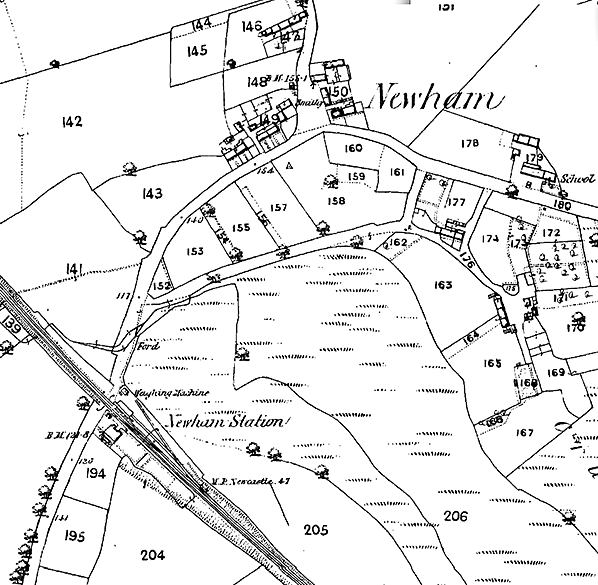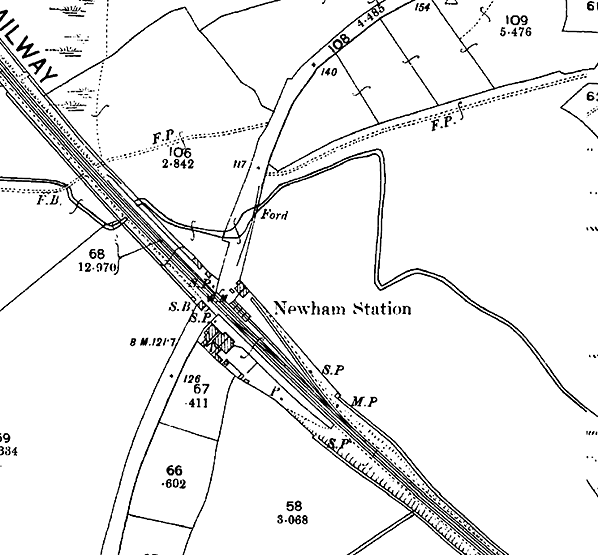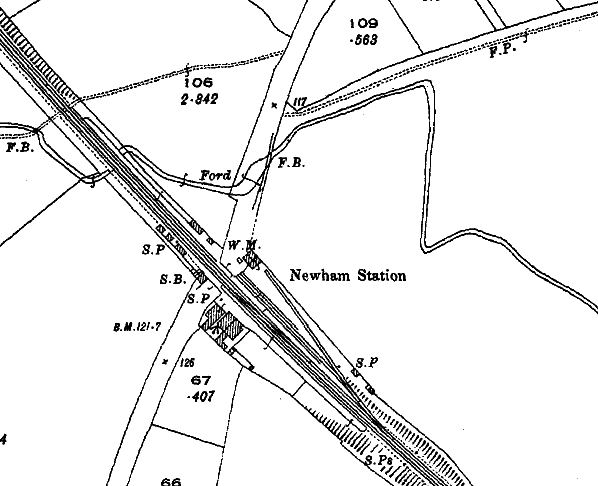
Station Name: NEWHAM[Source: Alan Young]
old2.jpg) Newham station looking north-west along the down platform c1910. In the foreground the semidetached cottages for the crossing keepers are seen. These pre-dated the station as they were constructed with the line, which opened in 1847, whilst the station did not come into use until 1851. Beyond the cottages a further two-storey house can be seen, which was the stationmaster’s residence. Beyond the level crossing is the North Eastern Railway signal box, an N1 design with a stone base, which was constructed by October 1877. The up platform is ‘staggered’ beyond the crossing, with a waiting shelter and a shed close to the crossing. A member of the station staff and two signalmen are to be seen.
Photo from John Mann collection  
1867 1:2,500 OS map. Newham station is named and its building – the crossing keepers’ cottages – is shown south-west of the level crossing, and two sidings are on the up (north-east) side opposite the site of the down platform. The siding closer to the main line serves the coal depot. The weigh office is shown as ‘Weighing Machine’. There is no indication of the platform or building north of the crossing, on the up side. The hamlet of Newham is also shown; it is remarkable that such a small settlement justified the provision of a station at all, considering that Chathill was only one mile south-east of Newham.

1897 1: 2,500 OS map. This map shows the additional building on the down (south-west) platform inserted between the level crossing and the crossing keepers’ cottages - now clearly indicated as two dwellings. The platform itself is now shown, as is the up (north-east) platform, on which the waiting shelter and the shed close to the crossing can be seen. The siding closest to the main line has the coal drops (coal depot) shown in more detail than on the earlier map, but the weighing machine is no longer named. The presence of the railway station has not caused any significant growth in the nearby hamlet of Newham.
 1923-24 1: 2,500 OS map. As the NER era closes and the LNER era opens, Newham station remains in its quiet rural setting with negligible change since the map of 1897. Three small buildings have appeared opposite the down platform.
old1.jpg)
Newham station looking south-west c1910. This photograph complements the first as all of the platform buildings are seen again, but from a different angle. The contrast between the charming ‘chalet style’ crossing keepers’ cottages, the distinctive NER hipped-roofed signal box and the characterless house between them can be appreciated. The rear of the waiting shelter and the shed on the up platform are seen to the right. A wagon is standing on the elevated track above the coal drops, and in front of it the small building with a pitched roof and pent-roofed extensions is the weigh office.
Photo from John Mann collection old3.jpg)
Newham station, c1920, looking north-west. This photograph was given to the author by the daughter of the stationmaster. It was probably taken at her father’s request to illustrate the station garden which he lovingly maintained. He has taken advantage of the cutting to announce the names of the railway company and the station, painstakingly cut out of the mown grass, and the platform is festooned with carefully tended flowerbeds and shrubs; it looks as if roses have been encouraged to frame the NER nameboard. Business was not brisk at Newham! Many stations were immaculately presented in pre-nationalisation days, and station staff fiercely contended for the awards for best kept station gardens. This one must have brought pleasure to passengers glimpsing it from passing expresses, even if there were few passengers who trod the platform at Newham with time to admire the gardens. The buildings in the background are clearly not intended to be the subject of this picture.
Photo from Alan Young collection 1.jpg)
The station house and crossing keepers’ cottages at Newham are seen from the level crossing c1971. The station closed to all traffic in 1950, and the edge stones of the down platform have been demolished and the infill gently graded to prevent it from collapsing onto the rails; the rear of the platform has been retained, behind the fence, to allow access to the cottages. The timber hut carrying a ‘Newham’ sign houses the ground frame, the signal box having been decommissioned. An NER oil lantern still lights the crossing.
Photo by John Mann 2.jpg) On 7 September 1972 Newham station is seen from a passing up train. The crossing keepers’ cottages seen in the earlier views have been demolished, but the station house remains in place. It can be seen that this building is of brick construction, rendered on the platform elevation perhaps in an attempt to make it blend with the sandstone of the cottages. The ground frame hut carries a nameboard from the former signal box, and an NER oil lantern is still in use. The North Eastern Railway trespass notice has appeared since the previous photograph was taken – fifty years after the NER ceased to exist.
Photo by Alan Young 3.jpg)
Looking south at the site of the former down platform of Newham station from the level crossing in May 2009. The crossing keepers’ cottages and station house have gone and this bungalow stands in their place. The posts and wire of the 1991 East Coast main line electrification scheme can be seen. A Corporate Identity nameplate identifies the location.
Photo
by Roy Lambeth
4.jpg)
A Class 221 Super Voyager on a down Cross Country service speeds through the site of Newham station at 13:07 on 19 May 2009. The building on the right was built on the station site prior to 2001.
Photo by Roy Lambeth 6.jpg)
Looking south-east from Newham level crossing in May 2009. The down platform of the former station was on the right of the tracks and the coal depot was to the left.
Photo by Roy Lambeth
|
 The Newcastle & Berwick Railway’s standard station layout was two facing platforms, but several of the additional ones provided by the York, Newcastle & Berwick and its successor, the North Eastern Railway, were given staggered platforms; in each case the platforms were on opposite sides of level crossings. Newham had this layout, with one platform placed in front of the crossing keepers’ cottages (down side, south-west of the crossing) and the other platform to the north-east of the crossing.
The Newcastle & Berwick Railway’s standard station layout was two facing platforms, but several of the additional ones provided by the York, Newcastle & Berwick and its successor, the North Eastern Railway, were given staggered platforms; in each case the platforms were on opposite sides of level crossings. Newham had this layout, with one platform placed in front of the crossing keepers’ cottages (down side, south-west of the crossing) and the other platform to the north-east of the crossing.  The first northbound departure of the day is shown to run as far as Beal; this train waited at Beal for about half-an-hour, moving off the main line to enable a northbound express to call, before completing its journey to Berwick. Passengers on the 10.14am ex-Newham could change at Belford or Beal to catch this faster train to Berwick or onward to Edinburgh.
The first northbound departure of the day is shown to run as far as Beal; this train waited at Beal for about half-an-hour, moving off the main line to enable a northbound express to call, before completing its journey to Berwick. Passengers on the 10.14am ex-Newham could change at Belford or Beal to catch this faster train to Berwick or onward to Edinburgh.thumb5.jpg)
thumb7.jpg)

 Home Page
Home Page